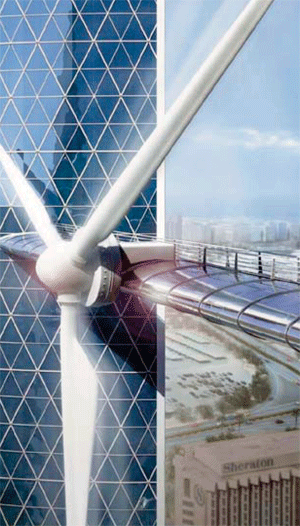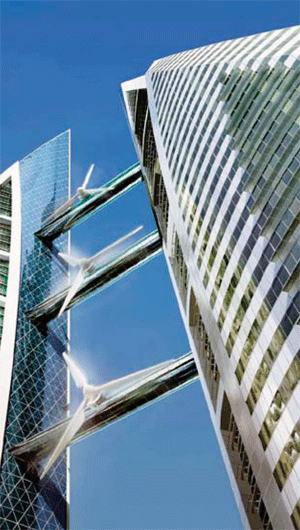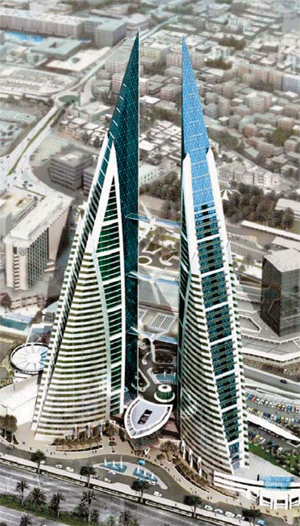
Intelligent building in Bahrain.
Due to the fact that the rate of global energy consumption in the world is constantly increasing, the need to develop renewable energy sources is becoming increasingly urgent.
Therefore, when the English architect Atkins decided to install huge wind turbines on the towers of the World Trade Center in Bahrain (BWTC – Bahrain World Trade Center), the attention of specialists from all over the world was riveted to this project.
“I’ve always wanted to use the power generation challenge in my projects,” says Shaun Killa, Head of Architecture at Atkins & Partners Overseas.
“A few years before the BWTC project, I started looking into the possibility of using large-scale wind turbines in the design of tall buildings. I knew for sure that no one had done this before, so we first had to understand the limitations of these devices.
We then had to combine this knowledge with building geometries that would be most favourable for wind flow, while at the same time remaining economically attractive.”
Killa noted that the site first came to his attention about three years ago, when the BWTC client asked Atkins to prepare a master plan for the site, which already included a Sheraton hotel, a small office building and a shopping centre.
The project was planned as a harmonious integration of the existing commercial complex, consisting of a shopping center, a 16-story office tower, and a 12-story Sheraton hotel.
Each of the two 50-story BWTC towers includes 34 office floors. The remaining floors are occupied by premises for additional services (fitness center, etc.).
The podium of the building includes a five-level parking lot designed for 1,700 cars.
The buildings feature 26 elevator systems, including four panoramic elevators that reach the 42nd floor, offering unforgettable views of the wind turbines operating against the backdrop of the city.
The client asked Atkins to extend the existing shopping mall, add office space and tie together all the facilities on the site.
The team began to survey the existing buildings and found that extending the site created a central axis perpendicular to the coastline of the Persian Gulf.
The first natural desire was to place both towers symmetrically on both sides of this axis. Killa noted: “As a sailor, during my first visits to Bahrain, I noticed how strong the wind blows from the sea here strictly perpendicular to the coastline.
It occurred to me that this could be a great opportunity to create two twin towers where wind generators of electric energy could be used.”

As a result, three centrifugal wind turbines with blade diameters of 29 m will be installed between the two BWTC towers, which are 240 m high.
Until now, similar projects have not existed, and therefore the developers did not have the opportunity to consult with any specialists.
Even when communicating with the turbine developers, questions arose that they could not answer.
As with any unique project, the design team faced a myriad of complex questions.
Research conducted by Atkins & Partners Overseas has shown that large-scale integration of wind generators inside buildings is not a good solution due to high costs (can reach up to 30% of the total construction cost).
This is primarily due to the costs of additional design of buildings, as well as research into the preparation of special wind turbines.
The success of the BWTC project is that standard turbines that had already been tested previously were used and incorporated into the project with minimal modifications. This allowed them to be integrated into the building at a low cost.
As a result, it was possible to achieve that the use of wind generators cost less than 5% of the total construction cost.
The big challenge was to correctly assess the behavior patterns of wind generators operating at height.
In open space, they could face the wind, but when the wind turbines are mounted on bridges connecting the two towers, it is a completely different operating mode.
In this case, it was necessary to consider how the shape of the towers would affect the air flow around the buildings.
In other words, the shape of both towers should create a “tunnel” that allows wind from the bay to pass between them, while simultaneously creating low pressure behind the buildings to speed up the air speed in the area of the turbines.
This architectural solution for the towers made it possible to increase the speed of the wind passing through the turbines by up to 30%.
Thus, according to Atkins' calculations, as a result of using wind power generators, buildings could save from 11% to 15% of their annual electricity consumption.
But, since this project has no analogues and wind turbines have never been placed at a height of 160 m from the ground, and in addition, between two high-rise buildings, the effect of their use can be even greater.
Both towers are connected in height by three bridges 31.7 m long, on each bridge wind power generators are fixed.
The bridges have special structures that allow the towers to move 0.5 m relative to each other.
The bridges were designed to withstand and absorb vibrations caused by wind and the rotation of turbines.
In addition to the installed wind generators of electrical energy, the BWTC project was noted as the first truly intelligent building in Bahrain.
Both towers are located in the center of the country's financial metropolis (Manama).
They will provide office workers with a new level of comfort and other benefits thanks to the use of the intelligent building management system IBMS (Intelligent Building Management Systems).
This system was implemented in collaboration with IT specialists and engineers from Xpand Advisory and NCS from Singapore.
BWTC towers will represent an unrivaled level of security, comfort and reduced operating costs.
In addition, all systems in the building will operate at the most modern level of communication: the buildings are equipped with SCS (structured cabling system), integrating all types of data.
Video surveillance system, automated access control, auto-parking functions and rapid response systems — all this is implemented in the BWTC project.

In terms of user convenience, the towers will implement functions that cover the automation of all stages of a person's stay in the building: from automatic parking to entering the building, taking into account VIP apartments, a reservation system for using services and services, as well as an accounting and billing system.
The IBMS system, in addition to including the most modern technologies, must also be scalable and have a high level of communication.
For example, the project development took into account the latest achievements in IP telephony, wireless access networks (hot spots), which provide access to voice mail, fax services and E-mail.
All this is carried out from a single access point, and people in the building can get broadband Internet access via a Wi-Fi connection.
Now users in the building can use any IT services as easily as standard services (for example, water supply or electricity supply).
In addition to providing IT communications facilities for individuals, the buildings offer great business opportunities for commercial structures.
Integrated building systems will reduce overall facility maintenance costs through energy efficiency and improved resource management.
The BWTC project is the first in Bahrain to design a fire suppression system in accordance with US NFPA (National Fire Protection Agency) standards.
Cost reduction was one of the goals pursued in the BWTC project. Electricity meters are installed on each floor of the buildings.
They are accessible to people on the floor and are also collected centrally to control energy costs.
Both buildings and the adjacent complex will be equipped with an innovative distributed air conditioning and refrigeration system.
This system takes into account optimal efficiency and cost reduction, providing an environmentally friendly alternative to conventional cooling systems through water recirculation.
Commenting on the intelligent building management system of BWTC, Claire Hughes, representative of DTZ Bahrain, said:
“The towers incorporate the most advanced systems and technologies.
The “smart” equipment installed in the project makes us proud that we were able to offer businesses a completely new level of conditions that allow them to work more “intelligently”.
One of the most important components of business activity today is productivity.
The environment created in the BWTC buildings with the help of modern technologies will allow companies to function more efficiently and will contribute to the growth of their businesses.”
The BWTC project has raised concerns among many people, as there were no similar projects before.
“It is always easier when someone has tried to do something like this before.
However, this project represents a precedent from which we can learn and advance progress in the construction of unique buildings further,” Killa concluded.

Добавить комментарий